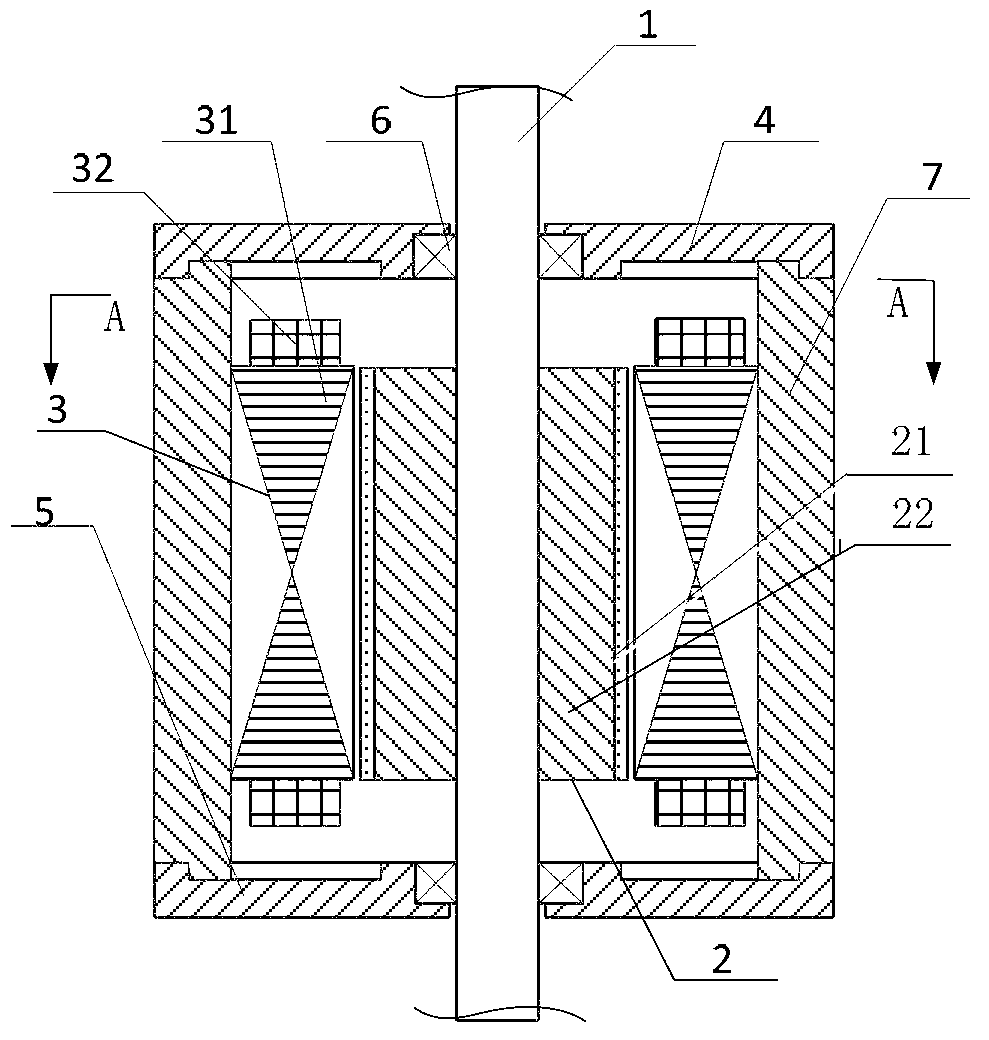Low-inductance low loss PMSM
A permanent magnet synchronous motor, low-loss technology, applied in synchronous motors with stationary armatures and rotating magnets, electrical components, electromechanical devices, etc., can solve problems such as increased core loss, high inductance, and low no-load loss. , to achieve the effect of increasing the high speed
- Summary
- Abstract
- Description
- Claims
- Application Information
AI Technical Summary
Problems solved by technology
Method used
Image
Examples
specific Embodiment approach 1
[0009] Specific implementation mode one: as figure 1 , figure 2 As shown, a low-inductance and low-loss permanent magnet synchronous motor includes a rotating shaft 1, a permanent magnet rotor 2, a stator 3, an upper end cover 4, a lower end cover 5, a bearing 6, and a housing 7. It is characterized in that the permanent magnet rotor 2 Comprising a rotor core 21 and a permanent magnet 22, the permanent magnet 22 includes a plurality of N and S poles, the N and S poles are arranged alternately or opposite to each other with the same polarity, and the permanent magnet 22 is placed on the surface of the rotor core 21 or built into the rotor core 21 Among them, the stator 3 includes a stator core 31 on which a single-phase or multi-phase stator winding 32 is radially wound, and the stator winding 32 is arranged in a circumferential direction, and each phase winding in the stator winding 32 includes one or more pairs of phases The distance between two adjacent coils is a pole pi...
specific Embodiment approach 2
[0011] Specific implementation mode two: as Figure 4 As shown, the difference between this embodiment and Embodiment 1 is that the permanent magnet rotor 2 includes two rotors, the inner rotor and the outer rotor, the inner rotor includes the inner rotor core 211 and the inner rotor permanent magnet 221, and the outer rotor includes the outer rotor core 212 and the outer rotor permanent magnet The magnet 222, the inner and outer rotors have the same number of poles, and the stator 3 is located between the inner and outer rotors. The stator winding is the same as that of Embodiment 1. In addition to the characteristics of Embodiment 1, this embodiment can effectively increase the torque of the motor by using the inner and outer windings of the stator.
specific Embodiment approach 3
[0012] Specific implementation mode three: as Figure 5 , Figure 6 , Figure 7 As shown, the difference between this embodiment and the above embodiments is that the rotor core 21 is a disc structure, the stator 3 and the rotor 2 are arranged axially, the stator core 31 is made of silicon steel sheets, and the stator core 31 is a concentric ring structure . A stator winding 32 is placed on the stator core, and its winding method and arrangement rules are the same as those in the first embodiment. The rotor magnetic field interacts with the stator current to generate torque, and the arrangement of the windings makes the motor have extremely low inductance and low core loss.
PUM
 Login to View More
Login to View More Abstract
Description
Claims
Application Information
 Login to View More
Login to View More - R&D
- Intellectual Property
- Life Sciences
- Materials
- Tech Scout
- Unparalleled Data Quality
- Higher Quality Content
- 60% Fewer Hallucinations
Browse by: Latest US Patents, China's latest patents, Technical Efficacy Thesaurus, Application Domain, Technology Topic, Popular Technical Reports.
© 2025 PatSnap. All rights reserved.Legal|Privacy policy|Modern Slavery Act Transparency Statement|Sitemap|About US| Contact US: help@patsnap.com



